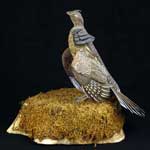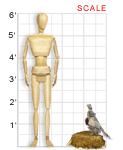VAM galleries including this work:
Kentucky Museum of Art and Craft | Animal Farm | Young at Art || VAM Home
Tim Hall (Kentucky, b. 1955)
RUFFED GROUSE, 1982
Carved and painted wood; 19" X 22" X 14"
Kentucky Museum of Art and Craft
The ruffed grouse is a species of North American game bird. The term ruffed was derived from some long, shiny, black or chocolate-colored neck feathers that are most prominent on the male. Tim Hall’s carved and painted grouse is so realistic-looking that it is often mistaken for a taxidermy bird.
About the Artist
Tim Hall of Ravenna, Kentucky, has a background in carpentry. He fell into the world of woodcarving by making a few pieces here and there and then realizing that people wanted to buy them. He started carving birds simply because he loved bird watching, duck hunting, and being outdoors. Hall has been working as a professional artist since the early 1980s. He is internationally known for his realistic wildlife carvings.
Classroom Ideas
Discussion: What style is this work? What are the challenges of creating a realistic-looking work of art? Compare this work to Marvin Finn’s Four-Headed Goose and other birds and to the paintings of birds in the John James Audubon Museum gallery of the Kentucky Virtual Art Museum. Which is it most like? What would happen if this piece were placed outside in a wooded area? Would people mistake it for a real bird? Would they walk closer to it and wonder why it was not flying away?
Activities: Choose a small item from nature, such as a leaf, a flower, a rock, or a twig, and try to draw it as realistically as possible.
Explore trompe l’oeil painting. This French term translates as “fool the eye.” Traditionally, trompe l’oeil is painted on a two-dimensional surface to make the surface appear three-dimensional. Hall used this effect when painting the feathers of the bird. He added the same eyes that are used by taxidermists to make the bird look even more life-like. Look at some examples of other works that “fool the eye,” then try your hand at it. Using a large sheet of paper and either paint or graphite, choose one or more items and draw them as realistically as possible. Using a shallow picture plane and life-like shading will help you achieve the goal.
Links
See more works by Tim Hall in the Gray’s Gallery of Sporting Art.
[grayssportingjournal.com/sporting_art/hall.shtml]
Visit the Ask/Art web site to see examples of trompe l’oeil painting.
[www.askart.com/interest/TrompePainting_a.asp]
Learn more about the ruffed grouse from the Ruffed Grouse Society.
[www.ruffedgrousesociety.org]

